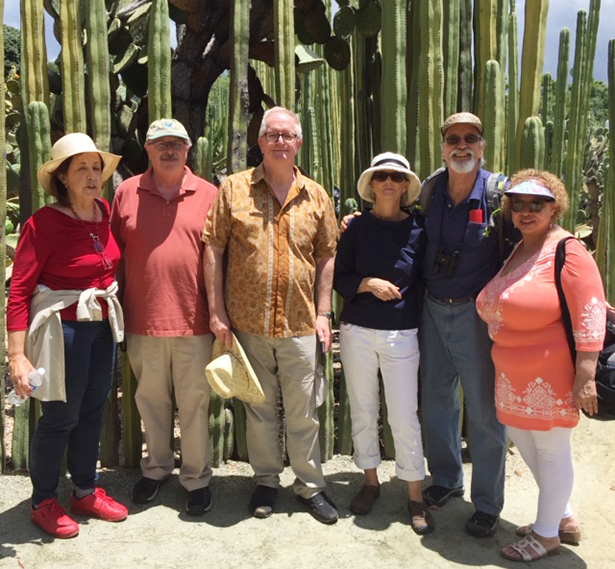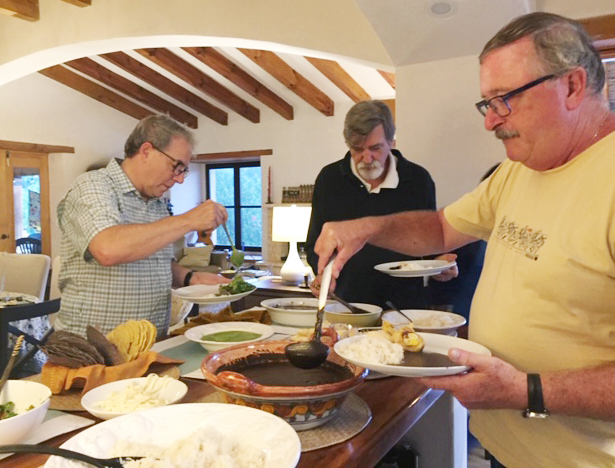NEWSLETTER
|
Letter from Mexico
EDAG, the Ford Foundation’s Environment and Development Affinity Group, was created in the mid-1990s as a mechanism for sharing learning and strengthening the work of Program Officers working in that broad arena around the world.
The staff working in that field gathered, almost annually, over nearly 10 years, in places of common programmatic interest. Those meetings generated a significant amount of collaborative grant-making. Over the years more than 20 program officers participated in EDAG meetings, as well as such senior staff as Betsy Campbell, Walt Coward and Suzanne Siskel.
Eight former Foundation staff who had participated in EDAG meetings, and four of their spouses, gathered in Oaxaca, Mexico, last August for an amazing and enjoyable week of activities. The schedule was organized by Deborah Barry and Michael Conroy, who live within one kilometer of each other in Oaxaca.
We spent much of our time focused on some of the most common EDAG themes: community-based environment and development projects, especially community forestry. Eight of the 20-or-so former EDAG program officers joined us, which we considered a pretty good turnout. The group included:
Three former program officers from China who had succeeded one another: Nick Menzies (1989 to 1995 in China, then 1995 to 2001 in East Africa), Jim Harkness (1995 to 2000) and Hein Mallee (1999 to 2004), as well as Nick’s wife, Melinda, and Hein’s wife, Shinko.
Jeff Campbell, who had served the Foundation in three locations: New Delhi for India and Nepal (1991 to 1996), Indonesia (1996 to 2000) and New York (2000 to 2008), along with his wife Christine.
Steve Lawry, who was Assistant Representative and program officer in Namibia (1992 to 1997), then Representative for the Middle East and North Africa in Cairo (1997 to 2001), and, in New York, Director of the Office of Management Services (2001 to 2006).
Michael Conroy, who had served in Mexico (1994 to 1998) and then in New York (1998 to 2003), and his wife, Lucy Atkin, who had been a Reproductive Rights program officer in Mexico from 1992 to 2000 also joined the group for much of the week.
Deborah Barry, who had succeeded Mike in Mexico from 1999 to 2005 and then seconded by the Foundation to the Center for International Forestry Research (CIFOR), and her husband, Baltazar Lopez.
And, last but far from least, Vernice Miller-Travis, who had focused on grantmaking around environmental justice in the New York office from 2000 to 2003 and had participated in a number of the annual EDAG meetings.
For many of us, this was the first time we had seen one another in as much as 20 years, so part of the early days were spent “catching up” on our various LAFF activities, with the interesting result that most of us are still involved with research and program activities linked to what we had supported while working at the Foundation.
All this while engaging in such optional activities as:
A visit to a successful hillside restoration, ecological education and outdoor art site, developed by the community where Deborah and Mike live, including a lunch created by a small, local women’s social enterprise focused on amaranth, and a discussion of the history, and recovery, of the cultivation of amaranth in the Oaxacan Central Valleys;
Participation in a tour of the Oaxacan Ethnobotanical Garden, with discussions of the edible and commercial and medicinal plants of the region;
An all-day and overnight visit to a Zapotec mountain town high above Oaxaca City where there is a 20-year history of successful FSC-certified community forestry, led by a community organization that has re-invested the surplus from their forestry enterprises into an ecotourism facility, a center for traditional medicine and other social services;
And, of course, a guided tour of two of the most distinctive pre-Columbian sites in Oaxaca, the magnificent Monte Albán ruins, and El Mogote, likely to have been one of the earliest human settlements in the region, reaching back to around 1500-500 BCE.
Oaxaca is one of Mexico’s most important and distinctive “culinary destinations”, so the week included both catered and restaurant meals replete with the specialties of the region, including moles of differing color and consistency; tlayudas, blue-corn tacos of every imaginable filling and flavor, and plenty of Oaxaca’s most important export beverage, mezcal.
Conversations inevitably turned to serious topics, such as pessimism about the authoritarian tendencies emerging in countries where we have worked, recognition that the core of the work of EDAG continues to have real importance in the evolving strategies for reducing poverty and inequality worldwide, and recognition of the even more important need to strengthen governance, both local and global, over our natural resources.
It was our consensus that local, community-based and small-scale efforts of the sort that the EDAG promoted remain an important process. They have proven to be significant bases for building both the assets and the resilience of communities isolated from, or bludgeoned by, global economic and political forces, and can inspire better global policies. As guiding light examples, more sustainable and environmentally preferable agricultural and forestry practices can be found in family farms and forests of the United States as well as those in Brazil, Indonesia, Mexico and Central America.
One hallmark of our work in EDAG had been combining local projects with a strategic global vision and global spheres of engagement. We were ahead of most developmental organizations, we believe, in tying the bigger explanations of climate change to the local trends and challenges of rural communities. With a presence in major worldwide meetings, we held conservationists’ “feet to the fire” through research and dialogue. By promoting global tenure reform and payment for environmental services, among other dimensions, Ford became one of the few organizations that could bridge this divide. EDAG meetings were essential for this, as they allowed us to share what was happening locally with colleagues around the globe.
EDAG, we concluded, was also an important tool for institutional memory, raising the question: How can an institution like the Foundation build and maintain institutional memory and make it accessible and useful to today’s programs without getting in their way?
Finally, we noted that EDAG has been good for all of us. Jeff Campbell now works at the United Nations Food and Agriculture Organization in Rome, focused on, yes, community forestry. Jim Harkness, based in his native Minnesota, consults frequently in, yes, China, on topics linked to developing community-based agricultural enterprises and the socio-environmental impact of Chinese foreign investment.
Hein Mallee works in a Japanese institute focused on environmental issues. Steve Lawry works on forest rights and governance at the Center for International Forestry Research (CIFOR), based in Washington, D.C. Nick Menzies holds a research position at the Huntington Library and Botanical Gardens in California, where he is working on a book on history and botany in China.
Deborah Barry just left the co-directorship of the H.G. Buffett Foundation/Catholic Relief Services program on sustainable agroforestry with a focus on soils and water management, and continues as an advisor to landscape restoration programs in Mesoamerica. Vernice Miller-Travis is working for a national environmental consulting firm where she serves as a senior advisor in its community planning and revitalization program and also leads the firm’s justice, equity, diversity and inclusion work.
And Michael Conroy is writing an analytical history of the Forest Stewardship Council, a principal target for his funding while at the Foundation, whose board of directors he had chaired from 2011 to 2015 after leaving the Foundation.
At the end of the week, during our last dinner together in a rooftop terrace restaurant under a full moon, the group was serenaded by Jeff Campbell, clearly the “Dean” of the EDAG program staff, when he whipped out a flute, hidden in his stocking, and played for all of us, to the applause of everyone in that restaurant.
|
Comments (1) |
| Patricia Krackov 4/10/2019 9:38:25 AM Great to see Mexico in the Laff news and see names and photos of so many folks from the 90's! Thanks for sharing. Must have been a great get together in Oaxaca. |



